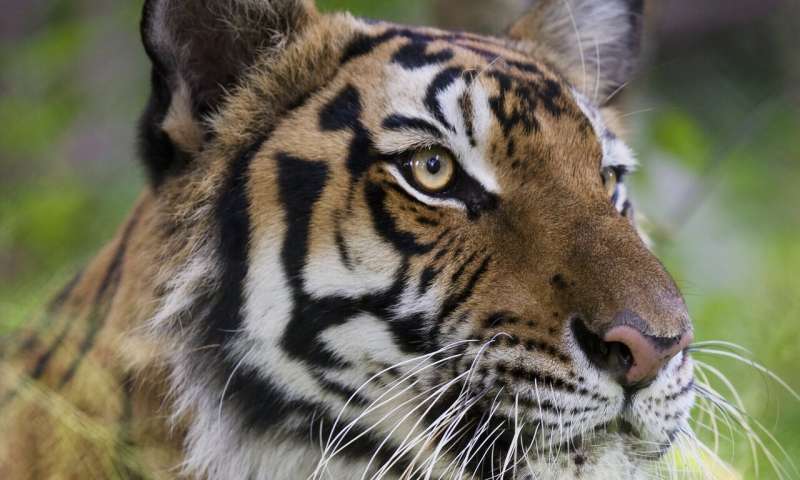Why captive breeding will not save the wild tiger

Let's be clear—tigers are perilously close to extinction.
There are fewer than 4,000 wild tigers in the world. The last sighting of a Javan tiger was in 1976, the Bali tiger disappeared even earlier; two subspecies, gone forever. Tigers have been wiped out in Cambodia, are 'functionally extinct' in Vietnam and Lao PDR, and are dangerously close to extinction in China. They have been decimated in Indonesia, with only the Sumatran population of fewer than 400 remaining. Sadly, Myanmar and Malaysia have this year reported significant population declines.
These catastrophic statistics are the result of habitat destruction, diminishing prey species, and poaching and trafficking of tiger parts and products. The latter feeds demand from countries such as China and Vietnam where rising disposable incomes fuel a thriving market for luxury goods, including for exotic animals such as tigers.
In contrast to wild tigers, the number of captive-bred tigers is reportedly growing. The Environmental Investigation Agency (EIA) estimates that there are 7,000+ tigers in captive-breeding facilities across China, Lao PDR, South Africa, Thailand and Vietnam. The vast majority of these facilities do not contribute to the conservation of tigers in the wild. What they do contribute to is persistent trade in tiger parts and products.
International response
In 1987 the Conference of the Parties to the Convention on International Trade in Endangered Species of Wild Fauna and Flora (CITES) – an international treaty to regulate wildlife trade—agreed to ban commercial international trade in tigers and their parts and products. In 2007, with strong leadership from key tiger range states, the Parties further agreed that tigers should not be bred for commercial trade and that countries should 'restrict the captive population to a level supportive only to conserving wild tigers."
And yet, monitoring by EIA shows that commercial captive-breeding of tigers has escalated, and that their parts are frequently trafficked alongside those from wild tigers.
Farmed and wild tigers are not made equal
Some argue (welfare concerns aside) that captive-bred tigers can form the basis of sustainable trade in tiger parts and products, sating market demand and, in turn, preventing wild tigers from being poached.
However, although likely to be commercially viable, farming tigers is unlikely to help protect the wild population. In fact, based on information available, it might well have the opposite impact.
Consumer research reveals an entrenched preference for wild-sourced tiger parts and products. Captive-bred animals are not perceived to have the same symbolic value, or medicinal potency, as wild ones. Traditional Asian remedies derived from wild animals that must fight for survival and eat a natural diet are considered more effective in restoring vital energy and maintaining good health. Displaying and gifting products from rare wild animals demonstrates wealth and status in a way that a farmed substitute cannot. Since captive-bred tiger products are not considered equal in quality or status, they are unlikely to supplant demand for wild tigers.
Nevertheless, a significant market also exists—including among those who cannot access the wild version—for more readily available products from captive-raised tigers. As the introduction of bear bile "farms" demonstrated, captive breeding of species where a market already exists may later amplify overall demand for wild-sourced products, due to a preference for these, and because the ready availability of legal, farmed alternatives removes any stigma previously attached to consumption of illegal products and reinforces misconceptions about their effectiveness and necessity.
Similarly, permitting legal domestic trade in captive-bred tigers serves to perpetuate the allure of tiger parts and products, and undermines efforts to reduce consumer demand. Ultimately, any increase in overall demand intensifies pressure on those remaining wild tiger populations clinging precariously to existence.
Moreover, breeding and keeping of tigers is a costly business. Poaching a tiger, on the other hand, requires only a wire snare. In the absence of sufficiently resourced and effective law enforcement across range, transit and consumer states, the laundering of wild-caught products into a legal commercial trade in captive-bred tigers is unfortunately inevitable.
What can be done?
If wild tiger populations are to endure, we must apply comprehensive poaching prevention strategies—including resolving human-tiger conflict—and work with a wide range of law enforcement and criminal justice sector agencies to strengthen law enforcement and dismantle trafficking networks.
Fauna & Flora International is committed to protecting Sumatran tigers and is playing a central role in global efforts to address illegal wildlife trade. This includes working closely with our government partners in the run-up to the CITES conference in Geneva later this month, with a view to ending international and domestic trade in all tiger parts, both wild and captive-bred. Only in this way can we turn the tide for this iconic but gravely endangered big cat.
Provided by Fauna & Flora International

















